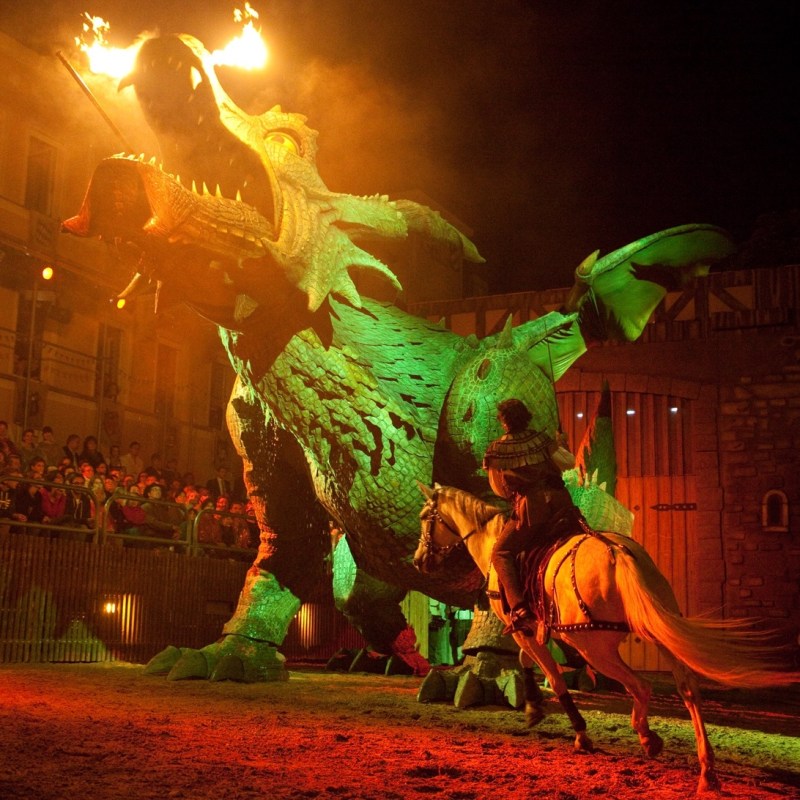
(Photo Credit: Drachenstich Festspiele e.V.)
Think of events or festivals in Germany, and most likely Oktoberfest and the traditional Christmas Markets will come to mind first and foremost. Maybe even the various asparagus festivals, celebrating the Germans’ beloved seasonal vegetable, come to mind. But otherwise?
Videos by TravelAwaits
Well, fret not. There are plenty of fun events and superb festivals in Germany to plan a vacation around, with some being awe-inspiring, such as the Kieler Woche, while others are based on history and culture. Yet, some festivals are rather bizarre and completely crazy, but utterly hilarious.
Here are some of the best and most unusual festivals and events to experience in Germany. Some you can even sign up for and participate in. Are you game?

(Photo Credit: Wattoluempiade)
1. Wattoluempiade
Brunsbuttel
With a play on two words, Watt and Olympics, for German speakers, there are clues in the name of this extraordinary event. The Watt is the muddy expanse of the River Elbe estuary by Germany’s North Sea coast. It’s an intertidal zone that leaves miles of flat, muddy ground perfect for getting, well, muddy. Add in “Olympics,” and there you have it: The Mud Olympics.
They are played out every year at low tide and bring together sports enthusiasts who are willing to get dirty and silly. Numerous teams from across Germany and neighboring countries team up to play football, or the like, in the mud, get thoroughly filthy, and raise plenty of cash for a cancer charity in the process.
Pro Tip: The Wadden Sea is a remarkable ecosystem that is well worth exploring, and, as long as you go with a guide and don rubber boots, you won’t even get terribly muddy, nor will you get caught by the incoming tide. There are gorgeous, tiny islands — the Halligen — on some of which you can stay to really experience this unusual terrain.

(Photo Credit: Christian Beeck)
2. Kieler Woche
Kiel
This sailing event is one of superlatives: Not only is it the largest sailing and regatta event in the world, but also the largest summer festival in Northern Europe. The Kieler Woche, or “Kiel Week,” brings together countless classes of sailing boats, grand old tall ships, and everything in between, even Viking ships and classic yachts, schooners, cutters, and more.

(Photo Credit: Sascha Klahn)
Attracting millions of visitors throughout the week, the Windjammerparade — the tall ship parade where 100-odd tall ships sail into the bay at 11 a.m. on the second Saturday of the week — is especially breathtaking. Add other non-sailing events — such as live music, a funfair, food stalls, and much more — taking place on land and you can easily spend the entire week there.
Pro Tip: The harbor city of Kiel on the Baltic Coast, some 60 miles northeast of Hamburg and 90 miles south of the Danish border, is a perfect hub from where you can explore the northern state of Schleswig-Holstein.

(Photo Credit: Drachenstich Festspiele e.V.)
3. Drachenstich
Furth Im Wald
Furth im Wald lies right on the Germany-Czechia border 100 miles east of Nuremberg in Bavaria. Here there is a lake called Dragon Lake; the city is called Drachenstadt, or “Dragon City;” and the forested region is steeped in folklore and myths. So, the clues are there.
Each year, the city re-enacts the legend of St. George slaying the dragon with a festival that will enthuse every dragon lover. After all, it seems that dragons are found around the world and there is no denying their appeal, even if they tend to get slain. The Drachenstich, the “Slaying of the Dragon Festival,” brings in not only the world’s largest walking dragon but also transforms the old city into a veritable time-warp destination. Throughout the old town, you’ll see medieval decorations, people donning medieval costumes, parades, and plenty of fun to be had everywhere.
Pro Tip: The only negative about this event taking place in the summer is that you will not be able to combine it with the Christmas Market in Nuremberg. But instead, why not go for a drink in Pilsen, the Czech city famous for its beer, some 45 miles east? The city is lovely and worth staying overnight.
4. Hirschrufen
Dortmund
Hirschrufen, or deer calling in English, is an artform — apparently. Those who participate in traditional hunts will know that there are numerous ways of imitating the call of wild deer, thus attracting them, only to then shoot the poor creatures. But this deer calling competition itself does not involve any bloodshed and instead makes you wonder why you have never seen anything like it over the years.
Taking place annually in Dortmund at the Hunt and Hound trade fair in North Rhine Westphalia, the competition is one of the fair’s highlights and draws even non-hunting enthusiasts. Dressed in traditional green outfits, the various contestants pull out either cow horns, or more modern implements looking like funnels, to compete in this centuries-old tradition.
Pro Tip: While this part of Germany is infamous for its coal and steel industry, the region is also dotted with cities such as Dusseldorf and Cologne, which are great for city breaks, as well as being a jumping-off point for the Rhine Valley.

(Photo Credit: Axel Thuenker)
5. Panem Et Circenses
Xanten
Bread and Games, also known as Swords, Bread, and Games, is one of the largest Roman festivals in the world, taking place every 2 years in the North Rhine-Westphalian city of Xanten, known for its Roman history. Formerly the expression for a politically-corrupt way of taking and not giving back to the common people, today it focuses more on social activities in the name of history and fun.
Some 500 “Romans” — be they gladiators, legionnaires, market-sellers, or humble citizens — descend on the city of Xanten to participate in a week-long festival of all things Roman, from gladiator fights and market displays to playing traditional games and eating the typical foods of the time.
The 2022 event has recently been canceled. But, look out for next year’s festival, currently slated for June 2024.
Pro Tip: To stick with the Roman theme, while you are there, don’t miss the 180-plus-acre Xanten Archaeological Park, which houses the remains of a Roman temple and settlement.
6. Entenrennen
Tübingen
In the southwest of Germany, in the state of Baden-Württemberg, a race with less serious contestants takes place every year in a rather scenic setting. The contestants are small, bright yellow, and normally swim in private bathtubs. Since 1999, 100 or so rubber ducks have been taking to the river, racing it out in the name of charity.
But, while seriously cute, the race is only a good excuse to visit the old university city of Tübingen with its colorful half-timbered houses lining the River Neckar. Here, you can go punting, or explore the old market square, the beautifully decorated 15-century town hall, the castle, and the quaint cobbled streets.
Pro Tip: Tübingen is surrounded by vineyards, and it would be a shame to miss out on those. Why not enjoy a tour of the surroundings and taste their best produce?

(Photo Credit: moreimages / Shutterstock.com)
7. Almabtrieb
Bavarian Alps
In the south of Germany, as well as in neighboring Austria, Almabtrieb is an annual event and celebration welcoming the cows, which spend the summer up on the green, wild meadows of the mountains. In September, they are herded back down into the valleys for the winter. But these are not just plain cows coming down into the valleys, these cows are decorated with flowers, ribbons, and tasseled garlands. Their big bells are polished and rung throughout the villages, which are in celebratory mode, and people line the streets to see the cows parade past.
Accompanied by traditionally dressed milkmaids and cowherds, this is a unique parade of beautiful cows and a much-loved culture. But, if there is a herd where the animals are not decked out in finery, that means that one of the animals sadly died up in the mountains.
Pro Tip: These parades usually take place around St. Michael’s Day, September 29, and each village and each farmer decks out their prized cows in different attire. Try to catch the celebrations in a few different places for variety.

(Photo by Miguel Villagran/Getty Images)
8. Fingerhakeln
Bavaria
Pulling someone’s finger might not seem like a sport to you and me, but to some, it is a very serious undertaking indeed. It’s even deemed a martial art. Every year, in annually-changing locations throughout Bavaria, the Fingerhakeln Meisterschaften (Finger Pulling Championships) take place.
They were traditionally carried out by men because these “fights” originated often in pubs over women, when men dueled for their favor. The tradition might seem truly Bavarian, but is indeed practiced in other countries such as Norway, Denmark, Finland, and further afield. Basically, the fight consists of two men sitting on opposite sides of a table and they either hook their middle or index fingers together, or sometimes use a strap instead, and pull. There is technique, skill, and pain involved, but eventually one opponent is pulled across the table and loses.
Pro Tip: Want to try it? If you want to stand a chance, you’ve got to train by putting your finger through a proper workout. Here are some instructions.
For more unique experiences in Germany, check out these articles:

